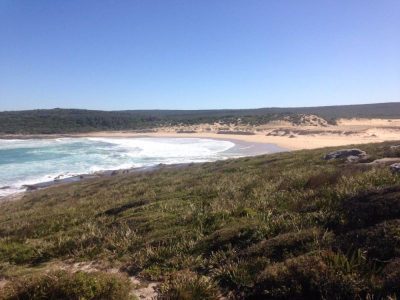QUARTZ SAND

Dunes and rugged sandstone coastline, Royal National Park (photo source: Megan Rowlatt)
I was privileged this morning to give a talk on Sydney beaches to the Probus Club at Souths Juniors. I love talking to these groups of retired folk, makes me feel young! And to venture into Rabbito territory, well that is another story for an old Easts/Rooster fan.
In these talks I love to tell the story of quartz and how we on the east coast are blessed with the presence of that mineral on our beaches and in our dunes.
Quartz is the second most abundant mineral in the Earth’s continental crust after feldspar. It has the chemical composition of silicon dioxide and is found in different types of rocks. It is a very common component of sand grains. Although colourless in its pure form, it often contains impurities within its crystal lattice, such as iron oxide giving grains of quartz sand a slight yellow or golden tinge.
We can trace back the presence of quartz sand on our beaches to the opening of the Tasman Sea as a result of sea floor spreading 60 to 80 million years ago. The result of this major tectonic event was what is called an asymmetrical rift with the Eastern Highlands being reactivated in elevation thus allowing east flowing rivers to incise and cut through the exposed continental margin. The other side of the rift drifted away to the east leaving a deep 3000-4000 metre basin, otherwise known as the ditch, separating us from what later become the shaky isles of New Zealand. Our side for the most part remained relative stable in tectonic terms, hence the application of the term passive continental margin to the east coast and highlands. Over time this margin slowly subsided allowing sea level to rise towards its present level.
Rivers draining the margin in years following the cessation of rifting cut into ancient igneous, sedimentary and metamorphic rocks all containing different proportions of quartz. Some of the sedimentary sequences were very rich in this mineral such as those in the Sydney Basin, for instance the Hawkesbury Sandstone. The rivers had many millions of years to deposit sediment on the continental shelf. Coarser grains were made available for reworking by waves and this is where the next part of the story begins.
As continents drifted apart and Australia broke away from Antarctica, the Southern Ocean was formed. This allowed for winds in these seas to drive waves from west to east and with storms up the Tasman Sea. The resulting swell and storm waves active on the continental shelf ground away the sands deposited by rivers. Two things happened: first, at lower sea levels than the present much of the sand was shunted northwards helping to create the great sand islands of southern Queensland. This long-lasting process has allowed Queenslanders to claim sand rights over their more deprived southern cousins when those cousins put obstacles in the way like training walls at the Tweed. Second, all the grinding action by waves reduced softer minerals to a finer fraction that was washed further seawards leaving behind the hard minerals like quartz and those less common heavy minerals such as rutile and zircon.
What we now see is the product of these processes operating across a continental shelf for millions of years since the Tasman Sea was formed. Unlike many coasts, there has been sufficient time to remove soft minerals and sufficient wave energy to do the grinding. Look at the grains under microscope and you will see how many are rounded. Look at similar size grains in the upper reaches of coastal rivers and you will notice how much sharper and more angular are their features. Peter Roy was one of the first to understand the significance of these differences back in the 70s. I am deeply indebted to him for his insights on these processes.
Compare these coastal sands of ours with those of New Zealand, Hawaii, California, UK, Mexico, Japan and the Mediterranean. By comparison, the sands of those places are mixed in colour, some say they look “dirty”. But they are the result of less time and less energy to remove softer sand sized minerals. Our east coast has been fortunate in so many ways to help provide the basis for its wonderful coastal lifestyle, but never let us forget the foundation for that coastal beauty and pleasure rests with its geology in allowing the formation over time of quartz sand beaches and dunes.
– words by Prof. Bruce Thom


 CLIMATE CHANGE LITIGATION
CLIMATE CHANGE LITIGATION